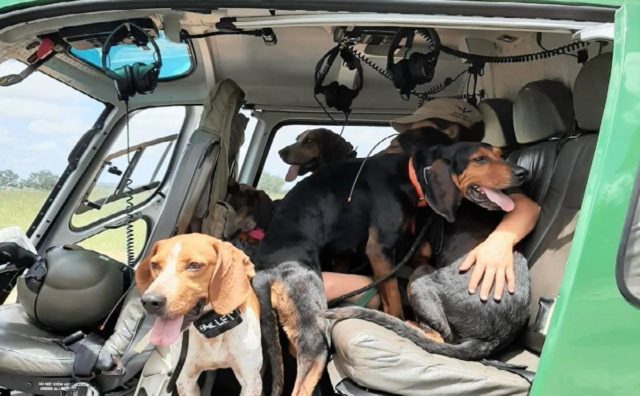
CAPABLE of tracking at phenomenal speeds for vast distances, free-running track dogs have proved to be hugely successful in the fight against poaching, particularly in catching poachers involved in the slaughter of rhino.
This week the International Rhino Fund (IRF), in the US, announced that a $100 000 grant (R1.7 million), will go to the Southern African Wildlife College (SAWC) to support training and anti-poaching operations to protect rhinos. The foundation has previously partnered with the college to provide K9 units and training to game reserve partners. The K9 units train rangers and dogs to assist in the detection and apprehension of poachers.
“We have been extremely impressed with their work and K9 units are a valuable asset in protecting rhinos,” said Nina Fascione, IRF’s executive director.
The SAWC, which has trained students from 56 countries and 127 wildlife areas, said the college was slowly reopening for student intakes after being closed because of Covid-19, which had seriously hampered their operations.
Their strategy to counter-poaching threats includes a combination of trained rangers, on- and off-leash hounds, community engagement and better land use to sustain ecosystems.
But it has been the free-tracking (off-leash) dogs which have been the “real game-changer”, with anti-poaching successes on the ground going from 3-5% without a canine asset, to more than 60% with the use of on-leash and free-tracking dogs.
Theresa Sowry, SAWC chief executive officer, said: “As part of our efforts to test best practice, we started using free-tracking dogs because they are able to track at much faster speeds than any human or dog on a lead can. This has proved to be a real game-changer.”
The college trains bluetick and redtick hounds, and black and tan hounds, which are an American breed of hunting dog developed for the hunting of raccoons, feral pigs, boars, bears and mountain lions. Other dogs trained at the K9 Unit include Belgian Malinois, bloodhounds and beagles which are used on-leash as detection and tracking dogs.
But it is the free-tracking hounds’ “noses”, speed and stamina which allow them to track for hours.
“These hounds have been used in tracking for hundreds of years and as such, they are genetically predisposed to doing this kind of work. We use free-tracking hounds for several reasons, first and foremost, this breed of canine has the most exceptional sense of smell. Their ‘noses’ are incredible and they will keep on tracking for hours on end. They can track at phenomenal speeds and maintain such speeds for vast distances. They are very athletic dogs, they are motivated and love to run. They are happiest when stimulated and working,” said Sowry.

She said one of the K9 Unit heroes has run a 30km track, “which she just refused to give up on. After the first 20km, we took her off the track and put fresh hounds onto it, so as not to cause exhaustion (protocol for any long tracking of poachers). But she refused to give up, while the team were getting her off the track, she climbed out of the bakkie window before anyone could stop her and joined her teammates. She ended up doing 30km that day and would have gone further if she could have. She has been responsible for the ruin of many a poacher’s ‘day’, having been involved in the most arrests,” said Sowry.
A fully grown tracking hound takes three months to train and become operational.
“A puppy is fully operational within 12 to 18 months from birth. Puppies need time to grow, mature and just be a puppy. When a puppy starts to show signs of maturity, we start with the full-time training. But we do start training puppies almost from the start by being playful with them, teaching them to pull on toys and getting them used to loud noises by banging and crashing on tins for example when they are eating,” said Sowry.
SAWC dog master Johan van Straaten said the handler must be able to “read” his/her dog and interpret the dog’s behaviour, while the dog must also understand how his handler operates.
“This is what makes them a great team,” he said, giving an example such as when a dog lost the scent track, the handler could see signs of an incursion, while the handler did not have the sense of smell or strength of the dogs.
“They are a passionate team who thrive on what they do and doing such important work to help protect our future conservation is an absolute privilege. What has been remarkable is seeing the percentage of ultimate successes (the poacher is arrested before the rhino is killed or severely wounded by poachers) go up, while also being able to remove weapons from the system,” said Van Straaten.







